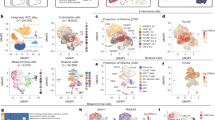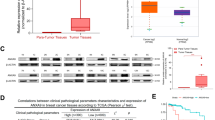Abstract
Tuftelin1 (TUFT1), an acidic protein constituent of developing and mineralizing tooth tissues, is regulated by hypoxia and the Hedgehog signaling pathway. We investigated the role of TUFT1 in hepatocellular carcinoma (HCC). qRT-PCR, immunohistochemistry and western blot were employed to evaluate TUFT1 level in HCC. MTT, BrdU, 3D culture and Transwell assays were used to assess cell viability, proliferation, in vitro growth, migration, and invasion. Subcutaneous and tail vein injection models were established to investigate in vivo growth and metastasis. Chromatin immunoprecipitation was performed to assess binding of hypoxia-inducible factor 1α (HIF-1α) to TUFT1 promoter. A microRNA array was used to identify hypoxia-related microRNAs. TUFT1 was elevated in HCC, and correlated with unfavorable clinicopathologic characteristics and poor survival. TUFT1 promoted HCC cell growth, metastasis and epithelial-mesenchymal transition in vitro and in vivo via activation of Ca2+/PI3K/AKT pathway. Hypoxia induced TUFT1 expression in an HIF-1α dependent manner, and TUFT1 expression was positively correlated with HIF-1α level in HCC tissues. Hypoxiaenhanced TUFT1 expression by downregulating miR-671-5p rather than by directly promoting the binding of HIF-1α to TUFT1 promoter. MiR-671-5p interacted with the 3′-UTR of TUFT1 mRNA and subsequently inhibited TUFT1 expression. Consequently, knockdown of TUFT1 blocked the effects of hypoxia in promoting HCC progression. TUFT1 promoted the growth, metastasis and EMT of HCC cells through activating Ca2+/PI3K/AKT pathway. The hypoxic microenvironment increased the expression of TUFT1 via downregulation of miR-671-5p. TUFT1 may function as a potential therapeutic target for the intervention and treatment of HCC.
This is a preview of subscription content, access via your institution
Access options
Subscribe to this journal
Receive 50 print issues and online access
$259.00 per year
only $5.18 per issue
Buy this article
- Purchase on Springer Link
- Instant access to full article PDF
Prices may be subject to local taxes which are calculated during checkout








Similar content being viewed by others
Change history
27 July 2022
A Correction to this paper has been published: https://doi.org/10.1038/s41388-022-02421-8
References
El–Serag HB, Rudolph KL. Hepatocellular carcinoma: epidemiology and molecular carcinogenesis. Gastroenterology. 2007;132:2557–76.
Bruix J, Sherman M. Management of hepatocellular carcinoma: an update. Hepatology. 2011;53:1020–2.
Maluccio M, Covey A. Recent progress in understanding, diagnosing, and treating hepatocellular carcinoma. CA Cancer J Clin. 2012;62:394–9.
Pouysségur J, Dayan F, Mazure NM. Hypoxia signalling in cancer and approaches to enforce tumour regression. Nature. 2006;441:437–43.
Harris AL. Hypoxia—a key regulatory factor in tumour growth. Nat Rev Cancer. 2002;2:38–47.
Rankin EB, Giaccia AJ. Hypoxic control of metastasis. Science. 2016;352:175–80.
Soni S, Padwad YS. HIF-1 in cancer therapy: two decade long story of a transcription factor. Acta Oncol (Madr). 2017;56:503–15.
Carnero A, Lleonart M. The hypoxic microenvironment: a determinant of cancer stem cell evolution. Bioessays. 2016;38:S65–S74.
Bristow RG, Hill RP. Hypoxia and metabolism: hypoxia, DNA repair and genetic instability. Nat Rev Cancer. 2008;8:180–92.
Giatromanolaki A, Harris AL. Tumour hypoxia, hypoxia signaling pathways and hypoxia inducible factor expression in human cancer. Anticancer Res. 2000;21:4317–24.
Jubb A, Hillan K. Expression of HIF-1α in human tumours. J Clin Pathol. 2005;58:1344–1344.
Wu XZ, Xie GR, Chen D. Hypoxia and hepatocellular carcinoma: the therapeutic target for hepatocellular carcinoma. J Gastroenterol Hepatol. 2007;22:1178–82.
Gwak G-Y, Yoon J-H, Kim KM, Lee H-S, Chung JW, Gores GJ. Hypoxia stimulates proliferation of human hepatoma cells through the induction of hexokinase II expression. J Hepatol. 2005;42:358–64.
Mao Z, Shay B, Hekmati M, Fermon E, Taylor A, Dafni L, et al. The human tuftelin gene: cloning and characterization. Gene. 2001;279:181–96.
Deutsch D, Palmon A, Dafni L, Mao Z, Leytin V, Young M, et al. Tuftelin–aspects of protein and gene structure. Eur J Oral Sci. 1998;106:315–23.
Deutsch D, Palmon A, Dafni L, Catalano-Sherman J, Young M, Fisher L. The enamelin (tuftelin) gene. Int J Dev Biol. 2003;39:135–43.
Leiser Y, Blumenfeld A, Haze A, Dafni L, Taylor AL, Rosenfeld E, et al. Localization, quantification, and characterization of tuftelin in soft tissues. Anat Rec. 2007;290:449–54.
Sliz E, Taipale M, Welling M, Skarp S, Alaraudanjoki V, Ignatius J, et al. TUFT1, a novel candidate gene for metatarsophalangeal osteoarthritis, plays a role in chondrogenesis on a calcium-related pathway. PLoS ONE. 2017;12:e0175474.
Leiser Y, Silverstein N, Blumenfeld A, Shilo D, Haze A, Rosenfeld E, et al. The induction of tuftelin expression in PC12 cell line during hypoxia and NGF‐induced differentiation. J Cell Physiol. 2011;226:165–72.
Oliveira F, Bellesini L, Defino H, da Silva Herrero C, Beloti M, Rosa A. Hedgehog signaling and osteoblast gene expression are regulated by purmorphamine in human mesenchymal stem cells. J Cell Biochem. 2012;113:204–8.
Zheng X, Zeng W, Gai X, Xu Q, Li C, Liang Z, et al. Role of the Hedgehog pathway in hepatocellular carcinoma. Oncol Rep. 2013;30:2020–6.
Zheng X, Vittar NBR, Gai X, Fernandez-Barrena MG, Moser CD, Hu C, et al. The transcription factor GLI1 mediates TGFβ1 driven EMT in hepatocellular carcinoma via a SNAI1-dependent mechanism. PLoS ONE. 2012;7:e49581.
Thiery JP. Epithelial–mesenchymal transitions in tumour progression. Nat Rev Cancer. 2002;2:442–54.
Altomare DA, Testa JR. Perturbations of the AKT signaling pathway in human cancer. Oncogene. 2005;24:7455–64.
Roberts PJ, Der CJ. Targeting the Raf-MEK-ERK mitogen-activated protein kinase cascade for the treatment of cancer. Oncogene. 2007;26:3291–310.
Wagner EF, Nebreda ÁR. Signal integration by JNK and p38 MAPK pathways in cancer development. Nat Rev Cancer. 2009;9:537–49.
Sliz E, Taipale M, Welling M, Skarp S, Alaraudanjoki V, Ignatius J. TUFT1, a novel candidate gene for metatarsophalangeal osteoarthritis, plays a role in chondrogenesis on a calcium-related pathway. 2017;12: e0175474.
Berridge MJ, Bootman MD, Roderick HL. Calcium signalling: dynamics, homeostasis and remodelling. Nat Rev Mol Cell Biol. 2003;4:517–29.
Zhang Y, Zhang T, Wu C, Xia Q, Xu D. ASIC1a mediates the drug resistance of human hepatocellular carcinoma via the Ca2+/PI3-kinase/AKT signaling pathway. Lab Investig; a J Tech Methods Pathol. 2017;97:53–69.
Davis FM, Azimi I, Faville RA, Peters AA, Jalink K, Putney JW Jr., et al. Induction of epithelial-mesenchymal transition (EMT) in breast cancer cells is calcium signal dependent. Oncogene. 2014;33:2307–16.
Wen L, Liang C, Chen E, Chen W, Liang F, Zhi X, et al. Regulation of multi-drug resistance in hepatocellular carcinoma cells is TRPC6/calcium dependent. Sci Rep. 2016;6:23269.
Poon E, Harris AL, Ashcroft M. Targeting the hypoxia-inducible factor (HIF) pathway in cancer. Expert Rev Mol Med. 2009;11:e26.
Lee J-W, Bae S-H, Jeong J-W, Kim S-H, Kim K-W. Hypoxia-inducible factor (HIF-1)[alpha]: its protein stability and biological functions. Exp Mol Med. 2004;36:1.
Choudhry H, Harris AL, McIntyre A. The tumour hypoxia induced non-coding transcriptome. Mol Asp Med. 2016;47:35–53.
Kulshreshtha R, Ferracin M, Wojcik SE, Garzon R, Alder H, Agosto-Perez FJ, et al. A microRNA signature of hypoxia. Mol Cell Biol. 2007;27:1859–67.
Chang Y-N, Zhang K, Hu Z-M, Qi H-X, Shi Z-M, Han X-H, et al. Hypoxia-regulated lncRNAs in cancer. Gene. 2016;575:1–8.
Dou C, Liu Z, Xu M, Jia Y, Wang Y, Li Q, et al. miR-187-3p inhibits the metastasis and epithelial–mesenchymal transition of hepatocellular carcinoma by targeting S100A4. Cancer Lett. 2016;381:380–90.
Xu S, Huang H, Chen Y-N, Deng Y-T, Zhang B, Xiong X-D, et al. DNA damage responsive miR-33b-3p promoted lung cancer cells survival and cisplatin resistance by targeting p21WAF1/CIP1. Cell Cycle. 2016;15:2920–30.
Meng H, Wang K, Chen X, Guan X, Hu L, Xiong G, et al. MicroRNA-330-3p functions as an oncogene in human esophageal cancer by targeting programmed cell death 4. Am J Cancer Res. 2015;5:1062.
Tan X, Fu Y, Chen L, Lee W, Lai Y, Rezaei K, et al. miR-671-5p inhibits epithelial-to-mesenchymal transition by downregulating FOXM1 expression in breast cancer. Oncotarget. 2016;7:293.
Li X, Zhang G, Luo F, Ruan J, Huang D, Feng D, et al. Identification of aberrantly expressed miRNAs in rectal cancer. Oncol Rep. 2012;28:77–84.
Hanahan D, Weinberg RA. Hallmarks of cancer: the next generation. Cell. 2011;144:646–74.
Kawasaki N, Isogaya K, Dan S, Yamori T, Takano H, Yao R, et al. TUFT1 interacts with RABGAP1 and regulates mTORC1 signaling. Cell Discov. 2018;4:1.
Ruan K, Song G, Ouyang G. Role of hypoxia in the hallmarks of human cancer. J Cell Biochem. 2009;107:1053–62.
Zhou B, Zhan H, Tin L, Liu S, Xu J, Dong Y, et al. TUFT1 regulates metastasis of pancreatic cancer through HIF1-Snail pathway induced epithelial–mesenchymal transition. Cancer Lett. 2016;382:11–20.
Acknowledgements
This study was supported by grants from the National Natural Science Foundation of China (81874049, 81773123, 81572847, 81502092); Innovation Capacity Support Plan in Shaanxi Province of China (2018KJXX-045); the Fundamental Research Funds for the Central Universities (7N010011015).
Funding
This study was supported by grants from the National Natural Science Foundation of China (81874049, 81773123, 81572847, 81502092); Innovation Capacity Support Plan in Shaanxi Province of China (2018KJXX-045); the Fundamental Research Funds for the Central Universities (7N010011015).
Author information
Authors and Affiliations
Corresponding authors
Ethics declarations
Conflict of interest
The authors declare that they have no conflict of interest.
Additional information
These authors contributed equally: Changwei Dou, Zhenyu Zhou, Qiuran Xu, Zhikui Liu
Electronic supplementary material
Rights and permissions
About this article
Cite this article
Dou, C., Zhou, Z., Xu, Q. et al. Hypoxia-induced TUFT1 promotes the growth and metastasis of hepatocellular carcinoma by activating the Ca2+/PI3K/AKT pathway. Oncogene 38, 1239–1255 (2019). https://doi.org/10.1038/s41388-018-0505-8
Received:
Revised:
Accepted:
Published:
Issue Date:
DOI: https://doi.org/10.1038/s41388-018-0505-8
This article is cited by
-
B-1 derived anti-Thy-1 B cells in old aged mice develop lymphoma/leukemia with high expression of CD11b and Hamp2 that different from TCL1 transgenic mice
Immunity & Ageing (2024)
-
A hsa_circ_001726 axis regulated by E2F6 contributes to metastasis of hepatocellular carcinoma
BMC Cancer (2024)
-
Assessment of TUFT1 and Rac1-GTP levels in triple-negative breast cancer patients: clinical and pathological correlations
Clinical and Translational Oncology (2024)
-
microRNA-128-3p inhibits proliferation and accelerates apoptosis of gastric cancer cells via inhibition of TUFT1
World Journal of Surgical Oncology (2023)
-
Tumor suppressor p53 mediates interleukin-6 expression to enable cancer cell evasion of genotoxic stress
Cell Death Discovery (2023)



